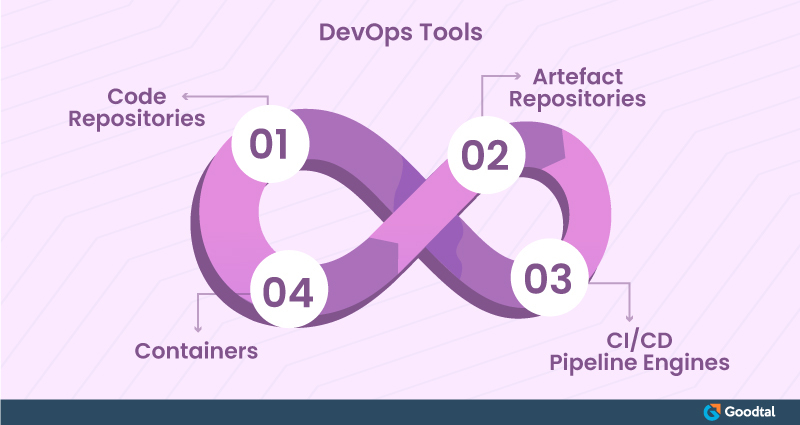
The word DevOps is a combination of Development and Operations, which means collaboration between the firm's application development and Information Technology operations team. In its narrowest sense, DevOps is about Software Development and its deployment on IT infrastructure by collaboration between teams.
DevOps is not a technology but a methodology that includes cohesive working between different teams to develop, deploy, and administer an IT project. DevOps make use of standard methodologies like:
- CI/CD - Continuous Integration and Continuous Delivery or Deployment with a focus on task automation
- Real-time monitoring, campaign management, incident management, and collaboration
- Microservices, Cloud Computing, and Containers implemented with DevOps
DevOps coexist with other technologies which IT firms use to execute software projects like Lean and Six Sigma strategies. It can be seen as a process with an infinite loop that includes writing algorithms, coding, testing, deploying, and monitoring via feedback.
DevOps Tools

DevOps is not about tools but about methodologies. DevOps practitioners use CI/CD pipelines, cloud hosting, and containers. Tools used can be open source, proprietary, or a combination of both.
Code Repositories
Several coders are working on the same project and may need to revert to a previous version of the code. Code repositories keep track of all the changes in the source code.
In the CI/CD pipeline, any change in code automatically triggers the next steps, which include static code analysis or build and unit tests. Code repository tools include Git and GitHub.
Artefact Repositories
Source code is transformed into an artefact for testing. Managing artefacts is a good practice in the same manner as managing source code is. Examples include JFrog Artifactory and Nexus Repository.
CI/CD Pipeline Engines
CI/CD provides a more accurate way of putting together the work of several people into one complete product. One important characteristic of the CI/CD pipeline, it uses automation to ensure the code quality. This reduces the time for deployment, provides continuous feedback and early error detection, and increases collaboration.
Containers
Containers can be described as a form of Operating System virtualization. It can be used to run a small microservice, software process, or a larger application. The container consists of libraries, binary code, necessary executables, and configuration files.
DevOps teams know that no matter where they are deployed, Container applications will remain the same. The technology provides streamlined build, test, and deployment from the same container images.
Adoption of DevOps Model
DevOps adoption needs change in culture as well as mindset. It is all about removing barriers of two different teams, which are development and operations. With the use of DevOps, the two teams work together to improve the productivity of developers and the reliability of operations. The teams interact frequently and try to improve the quality of services. The team members take full responsibility for the services regardless of their stated roles.
How DevOps Works?
Some practices help organizations innovate faster by streamlining and automating software development and deployment process. Proper tools are required to achieve this goal.
One essential practice is to constantly provide updates, which are frequent but small. The updates are more incremental in nature than the regular updates, which are released as a traditional practice. These frequent updates make it easier to find bugs as developers only have to identify the last update which caused the error.
Organizations using DevOps release many more updates than firms using traditional software development practices. These organizations may also use microservices architecture to increase flexibility and quicker innovation. This architecture breaks down large complex systems into small projects. Each project has an agile team that takes complete ownership of the sub-task.
However, having so many teams and frequent updates does mean many operational challenges. DevOps practices like CI/CD address these challenges allowing organizations to deliver rapidly and safely. To keep computing resources elastic and responsive to constant changes, infrastructure automation practices like Infrastructure as code and configuration management are used.
Infrastructure as a code is a practice in which infrastructure is managed using software development techniques, such as continuous integration and version control. The Cloud’s API-driven architecture allows System Administrators and Developers to interact with infrastructure programmatically. As they are defined by code, servers and infrastructures can be deployed using standardized patterns with the latest patches and versions.
Configuration Management
System Administrators and developers use code to automate Operating System and host configuration. This saves time as they don’t have to manually configure Operating Systems or server software.
Policy As Code
Organizations can monitor and enforce compliance with infrastructure and its configuration programmed within the cloud. Infrastructure defined by code can be tracked, authenticated, and reconfigured in an automated way. This allows companies to ensure compliance across all departments.
Why Should You Not Ignore DevOps?

1. It Can be Used to Automate a Lot of Processes
It has been proven long ago that investing in automation does cost a substantial sum initially. However, over a period of time it pays off. So, automate CI/CD pipelines, databases, servers and Implement the Infrastructure as Code(IaaC) approach.
2. DevSecOps Takes Care of Security Need
With many employees working remotely, cyber security is always a top priority. Robust security policies and protocols are necessary both for users and employees. In case of negligence by either, it can cost a handful. DevSecOps approach is fast gaining popularity as it can detect any loopholes in your security policies and fix them before any breach happens.
3. DevOps Significantly Reduces Operations Cycle Time
When the development and operations teams are working separately, it becomes tough to tell if the application will be ready for operations. The operations team has to go through an extended cycle for each deployment.
However, this cycle time is reduced significantly when the two teams work together. In this fast-paced world, software firms that are able to innovate faster will stay ahead of the rest.
4. Reduces Cost
DevOps teams require 35% less IT staff and 30% lower IT costs. A study on DevOps has found that top DevOps organizations perform far better on development speed and deployment. As a result, these organizations become efficient and are able to deliver much faster.
5. Promotes Collaboration
When Software development & deployment teams work together, chances of improving satisfaction and productivity increase. The development and operations teams no longer work towards individual goals, but their combined goal is to improve performance. The experiments and innovations are more effective, and the product reaches the market on time.
How DevOps Will Change in Near Future
Although the technology has just been around for over a decade, it is evolving. Some of the ways in which it will evolve are
AI & Data Science
DevOps technology can be made better by incorporating Artificial and Machine learning capabilities. With increasing amounts of data being generated by environments, consumers, and markets, it can be used to increase productivity and revenues.
Serverless Architecture
Serverless platforms allow DevOps teams to focus on their code rather than worry about hosting Operating Systems. These platforms provide scalability, User Experience, and deployment speeds that cannot be matched.
Cloud-Native
The concept of cloud computing has grown over the years. Containers & microservices make up many cloud applications and are used in many pipeline deployments. Developing cloud-native applications requires automation and agility, which are not achievable without making use of DevOps strategies.
DevSecOps
Security cannot be ignored while developing applications in an automated CI/CD pipeline. In a complex microservices architecture, it should be incorporated right from the planning and development stages.
“The global DevOps market size was valued at $ 6.78 billion in 2020 and projected to reach $ 57.90 billion by 2030, with a CAGR of 24.2% between 2021 and 2030.”-Allied Market Research
Conclusion
The DevOps culture is about shifting from traditional System Development Life Cycle (SDLC) to DevOps LifeCycle Management, which provides several advantages to a Software Development company. The entire team works as one unit to deliver the best to their clients and make the company stand out. At the same time, other criteria should not be ignored while implementing DevOps. When DevOps’s future technology will use multi-cloud environment, team will be able to innovate in a productive and supportive space. We will also see new tools and platforms to deal with ordinary deployment details. All these technologies, including Automation and Artificial Intelligence will make DevOps a much sought after methodology.
For DevOps implementation & solutions, Goodtal lists the best talent for you.

